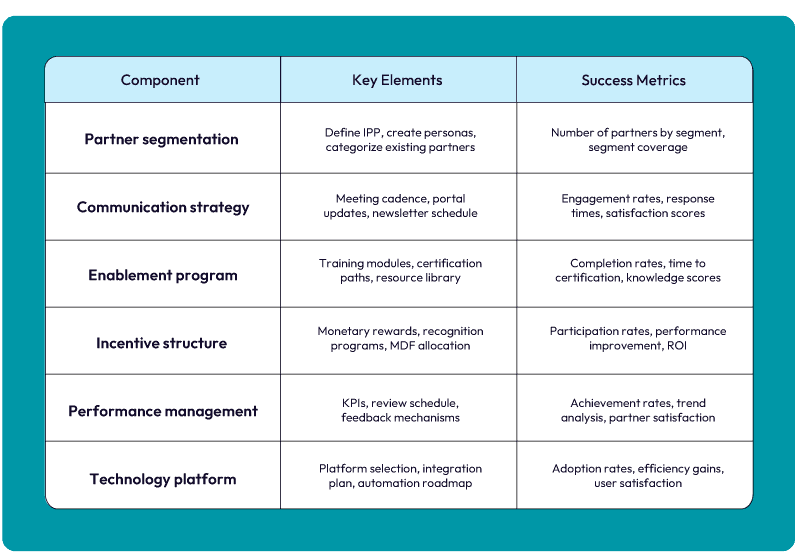In today’s competitive business landscape, companies can’t afford to do it alone. Strategic partnerships have become essential for expanding market reach, driving innovation, and accelerating revenue growth. Yet many organizations struggle to move beyond transactional relationships with their partners, missing out on the transformative potential of truly engaged partnerships. The difference between a thriving partner ecosystem and a stagnant one often comes down to one critical factor: partner engagement.
Increasing partner engagement and maximizing the impact of your partner ecosystem is essential to business growth — whether you’re launching your first channel partner engagement strategy or looking to revitalize an existing program,
This comprehensive guide explores what partner engagement really means, why it matters more than ever, and how to build a strategic approach that transforms partners from passive participants into active growth drivers.
What is partner engagement?
Partner engagement refers to the strategic processes and practices that foster active collaboration and shared success between your organization and its business partners. It encompasses all the ways you involve and interact with partners in your ecosystem — from regular communication and training sessions to joint marketing initiatives and collaborative product development.
At its core, partner engagement is about creating an ongoing dialogue and building relationships that support mutual success. This goes far beyond simply onboarding partners and hoping they’ll promote your products. True engagement requires consistent effort to enable, activate, and incentivize partners throughout their entire journey with your organization.
Types of partners in your ecosystem
Partner engagement strategies must account for different partner types, each bringing unique capabilities and value:
- Channel partners: Resellers and distributors who sell your products or services to end customers
- Affiliates: Marketing partners who promote your offerings in exchange for commissions
- Strategic alliances: Organizations with complementary offerings that collaborate on joint solutions
- Technology partners: Companies whose products integrate with or enhance your solutions, sometimes called integrations
- Service providers: Consultants and implementation specialists who deliver your solutions to customers
Why partner engagement matters
The business case for prioritizing partner engagement is compelling. Companies with highly engaged partners consistently outperform those with passive partner relationships across multiple dimensions.
Revenue growth and market expansion
Engaged partners drive significant revenue impact. Research shows that companies implementing structured partner engagement programs report annual revenue increases averaging 9.6%, compared to just 3.0% for organizations without such programs.
Beyond direct revenue, engaged partners help you access new markets and customer segments that might be difficult to reach independently. They bring local market knowledge, established customer relationships, and geographic presence that would take years to build organically.
Enhanced customer satisfaction and loyalty
When partners are well-engaged, they provide better customer service and support, leading to higher customer satisfaction and retention rates. Your partners often serve as the primary touchpoint for customers, making their engagement level directly impact how customers perceive your brand. Disengaged partners may deliver your brand message incorrectly or inconsistently, seriously impacting your market reputation.
Innovation and competitive advantage
Collaborative partner relationships often lead to innovative ideas and solutions that benefit both parties and drive competitiveness. A network of engaged partners gives your company a competitive advantage by increasing your reach and capabilities beyond what you could achieve alone.
Resource efficiency and risk mitigation
Engaged partners use resources more efficiently, reducing the need for extensive partner management and support from your team. They’re also more likely to work collaboratively to identify and mitigate risks, leading to more robust contingency plans and quicker responses to unforeseen challenges.
Pillars of a successful partner engagement plan
Building an effective channel partner engagement strategy requires a structured approach built on several foundational pillars.
Setting clear objectives and KPIs
Before engaging with partners, establish clear objectives that align with your overall business goals and communicate them effectively to all partners. These objectives provide direction and ensure everyone works toward the same outcomes.
Effective KPIs for measuring partner engagement might include:
- Partner-influenced revenue and deal registration rates
- Training completion and certification achievement
- Marketing campaign participation and co-marketing activities
- Customer satisfaction scores for partner-delivered services
- Time to first deal and average deal size
- Partner portal login frequency and resource utilization
Regular performance reviews based on these metrics help assess partnership effectiveness and identify improvement areas.
Partner segmentation for tailored engagement
Not all partners are created equal, and one-size-fits-all engagement strategies rarely work well. Segment your partners based on factors like:
- Capability and maturity: Technical expertise, sales capacity, and market presence
- Geographic focus: Regional or global reach and local market knowledge
- Industry specialization: Vertical expertise and customer base
- Strategic value: Revenue potential and alignment with your growth priorities
- Engagement level: Current activity and commitment to your partnership
Once segmented, create persona-driven strategies that customize communications, resources, and support for each partner type. Identify these personas clearly in your partner portal so you can tailor collaboration to what each segment cares about most.
Channel partner engagement strategy essentials
A comprehensive channel partner engagement strategy addresses the entire partner lifecycle, from recruitment through ongoing collaboration.
Recruitment and alignment
Start with a well-defined Ideal Partner Profile (IPP) that reflects your current company goals, target markets, and product portfolio. Your IPP should evolve as your business changes — dramatic shifts in your go-to-market approach should warrant IPP revisions and adjustments to your recruitment strategy.
You may need multiple IPPs to maximize presence across different regions or industries. Once you’ve identified ideal partners, prioritize them for engagement and fold yourself into their existing strategies. If they conduct frequent webinars, offer to be a panelist. If they’re active on social media, propose collaborative campaigns.
Communication and collaboration
Open and transparent communication is the cornerstone of effective partner engagement. Establish regular check-ins and quarterly business reviews to maintain continuous dialogue, build trust, and address issues promptly.
Foster open communication through multiple channels:
- Scheduled one-on-one meetings with partner managers
- Quarterly business reviews to assess performance and alignment
- Partner advisory boards for strategic input
- Online forums and community platforms for peer-to-peer connection
- Regular newsletters and product updates
Setting a recurring meeting cadence with all partners helps you stay top of mind and build trust in each relationship.
Joint business planning
Engage in strategic business planning sessions with your partners, especially top performers. Collaboratively set goals, create action plans, and align strategies to ensure you’re working toward shared objectives like revenue targets or market expansion. These joint business plans should outline sales, marketing, and revenue targets while detailing the activities needed to accomplish them, enabling data-driven quarterly reviews that provide business insights for the future.
Plan to conduct annual business planning meetings where you review past performance, set new goals, and co-create strategies for growth.
How to increase partner engagement
Moving from strategy to execution requires specific tactics that empower partners and motivate ongoing participation.
Empower partners with enablement and training
The ultimate engagement goal is helping partners become self-sufficient — teaching them to fish rather than constantly providing fish. However, this can’t come at the expense of rigor. Without proper enablement, you risk putting customer relationships in jeopardy through incorrect technical answers, overpromising, or underdelivering.
Offer comprehensive training programs that include:
- On-demand, self-paced courses: Meet busy partners where they are with flexible learning options.
- Certification programs: Provide credentials that validate expertise and motivate achievement.
- Multilingual resources: Support global partners in their preferred languages.
- Interactive content: Provide quizzes, surveys, and hands-on exercises that invite active participation.
- Centralized partner portals: You should have a single access point for all training materials and resources.
Explain why training is critical and what partners will gain from it — whether through certifications, exclusive content access, or special support pathways. Update training regularly in conjunction with new product releases and refresh content every few years to maintain relevance.
Incentives, recognition, and MDFs
Draw partners in with worthwhile incentives — the sweeter they are, the better partner performance you’ll see. Effective incentive programs include both monetary and non-monetary rewards.
Monetary incentives include:
- Performance-based commissions and bonuses
- Tiered rebate programs that reward higher achievement levels
- Market development funds (MDFs) for co-marketing activities
- Deal registration bonuses for bringing new opportunities
Non-monetary incentives can refer to:
- Public recognition through awards and partner spotlights
- Exclusive access to new products or beta programs
- Speaking opportunities at company events
- Seats on partner advisory boards
- Increased exposure through branded content and press releases
Ensure incentive programs align with partnership objectives and create a sense of buy-in by involving partners in joint business planning and goal-setting.
Feedback systems and continuous optimization
You won’t truly know what makes partners tick unless you ask them. That’s why you should implement systematic approaches to gather and act on partner feedback.
Establish multiple feedback channels, such as:
- Partner surveys conducted quarterly or biannually
- Real-time dashboards showing performance analytics
- Feedback sessions during quarterly business reviews
- Partner advisory board meetings for strategic input
- Community forums where partners can share experiences
- Direct conversations during regular check-ins
Use insights from feedback to address concerns, make improvements, and enhance the overall partner experience. Create a running list of potential engagement strategies and set goals to implement a certain number each quarter, then measure incremental impact to determine what’s worth continuing.
Unique partner engagement strategies most vendors miss
While many organizations focus on the fundamentals, leading partner programs differentiate themselves through advanced approaches that most competitors overlook.
Leveraging advanced PRM technology and automation
Modern partner relationship management (PRM) platforms offer capabilities that go far beyond basic partner portals. Advanced features include:
- AI-powered chatbots: Provide instant answers to partner questions 24/7
- Predictive analytics: Identify at-risk partnerships and high-potential opportunities before they’re obvious
- Automated workflows: Streamline deal registration, MDF requests, and lead distribution
- Integration with CRM and marketing automation: Create seamless data flow between systems
- Real-time performance dashboards: Give partners visibility into their progress and achievements
These technologies enable scalable engagement strategies, ensuring all partners receive necessary support and communication regardless of their number — crucial for sustaining long-term partnerships.
Personalization at scale
Generic, one-size-fits-all content no longer suffices in today’s channel. Leading programs deliver personalized experiences by:
- Tailoring content and resources by partner segment and maturity level
- Customizing training paths based on partner roles and expertise
- Providing industry-specific marketing materials and sales tools
- Offering localized content that respects cultural and regional differences
- Delivering personalized recommendations based on partner behavior and performance
Partner relationship management systems with robust analytics and performance tracking capabilities enable this personalization by monitoring partner activities and providing insights into areas for improvement.
Building a collaborative community
Create opportunities for partners to connect with each other, not just with your organization:
- Online forums and discussion boards: Enable peer-to-peer knowledge sharing.
- Regional or virtual networking events: Facilitate relationship building among partners.
- Innovation challenges: Invite partners to submit ideas for new features or solutions.
- User groups: Organize communities around specific products or industries.
- Co-innovation programs: Collaborate with partners on developing new offerings.
A strong community fosters a sense of belonging and collective success, while encouraging partners to bring innovative ideas and creative solutions to the table.
Supporting partners’ sustainability and CSR initiatives
Differentiate your program by aligning with partners’ corporate social responsibility goals:
- Highlight how your products support sustainability objectives
- Offer joint CSR initiatives that partners can participate in
- Provide resources for partners to communicate environmental benefits to customers
- Recognize partners who demonstrate leadership in sustainability
- Create programs that give back to communities where partners operate
This approach builds deeper emotional connections and aligns partnerships with broader societal values.
How to handle non-engaged partners
Despite your best efforts, some partners will remain disengaged. Addressing this proactively is essential for program health.
1. Identify disengaged partners
Watch for warning signs, including:
- Declining or stagnant sales performance
- Low participation in training and certification programs
- Minimal use of partner portal and resources
- Infrequent communication and missed meetings
- Lack of marketing activity or co-marketing participation
- Negative feedback or complaints from their customers
2. Leverage re-engagement tactics
Before parting ways, attempt to revitalize the relationship:
- Conduct resource audits: Assess whether partners have what they need to succeed.
- Provide targeted support: Assign dedicated resources to help overcome specific obstacles.
- Offer stepwise involvement: Create low-barrier entry points for renewed participation.
- Revisit alignment: Ensure the partnership still makes strategic sense for both parties.
- Share success stories: Demonstrate what engaged partners are achieving.
- Adjust tier requirements: Consider whether expectations are realistic.
3. Know when and how to part ways
If re-engagement efforts fail, it may be time to end the partnership. Do so professionally by:
- Providing clear communication about the decision and reasoning
- Offering transition support to minimize customer disruption
- Maintaining positive relationships for potential future collaboration
- Learning from the experience to improve future partner selection
- Documenting lessons learned to refine your IPP and recruitment process
Emerging trends in partner engagement
The partner landscape continues evolving rapidly. Stay ahead by preparing for these emerging trends.
Data-driven strategies and AI-powered insights
Advanced analytics and artificial intelligence are transforming how organizations engage partners. Expect to see:
- Predictive models that identify which partners are likely to succeed or struggle
- AI-driven content recommendations tailored to individual partner needs
- Automated engagement triggers based on partner behavior patterns
- Sentiment analysis of partner communications to gauge satisfaction
- Machine learning algorithms that optimize incentive structures
These data-driven approaches enable proactive engagement rather than reactive problem-solving.
Global expansion and localization challenges
As businesses expand internationally, partner engagement becomes crucial for navigating local regulations and customs.
Successful programs will need to:
- Provide multilingual support and resources
- Adapt engagement strategies to cultural preferences
- Navigate varying regulatory requirements across markets
- Balance global consistency with local flexibility
- Build regional partner communities while maintaining global alignment
Preparing for ecosystem growth
The future belongs to partner ecosystems, not just individual partnerships. Forward-thinking organizations are:
- Creating marketplace platforms where multiple partners can collaborate
- Facilitating partner-to-partner connections and co-selling opportunities
- Building technology ecosystems with integrated solutions
- Developing community-driven innovation programs
- Establishing governance models for complex multi-partner initiatives
Future-proof your channel partner engagement strategy by building scalability into your systems and processes from the start.
Partner engagement plan template
To help you implement these strategies, here’s a framework for building your own partner engagement plan, plus a step-by-step strategy checklist.


Maximize partner engagement
Partner engagement is not a one-time initiative, but an ongoing commitment to building mutually beneficial relationships that drive growth for all parties involved. By implementing the strategies outlined in this guide, you can transform your partner ecosystem from a passive network into an active growth engine.
Ready to turn partner engagement into revenue? Fuel brand-to-local growth with a platform and services that synchronize your distributed partner ecosystem. With Ansira, you can empower your partners to market compliantly, access funds and rewards, and activate local campaigns that convert.
Connect with our channel experts to assess your program.




